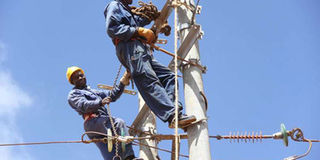Kenya Power’s huge appetite for debt is a recipe for disaster

Kenya Power workers fix electricity poles. PHOTO | FILE | NATION MEDIA GROUP.
What you need to know:
- At the end of 2015, Kenya Power was sitting on a cash pile of Sh28 billion, which has dwindled to a mere Sh5 billion at the end of last June.
- Profit before tax is stagnant and revenues have not grown at par with the speed of new customer connections.
One of the big economic news items last week was the change of guard at the critical utility, Kenya Power. There was a lot of celebratory talk about the performance of the company as outgoing CEO Ben Chumo handed over the reins to the acting managing director, Mr Ken Tarus.
Another major change occurred within the board with the influential lawyer and accountant, Mr Kairu Thuo, replacing long-serving director Macharia Kariuki. The truth is that this otherwise mundane change within the board was no less significant in terms of quiet shifts in the balance of power in the governance of this strategic parastatal.
But what is the state of the health of the company as Chumo exits?
Without doubt, a great deal has been achieved, especially in terms of expansion. For instance, electricity connections increased exponentially — from 2.3 million in June 2013, when Chumo took over, to4.7 million in June last year. Chumo has presided over an unprecedented period of capital expenditure.
The flip side is that Chumo has left behind a company in massive debt. The debt-driven expansion programme that he presided over is what has helped this strategic parastatal sustain appearances of prosperity.
According to the company’s 2016 annual accounts, borrowing ballooned to a massive Sh105 billion last year, causing finance costs to hit the roof. It is not incredible that one local commercial bank is exposed to Kenya Power to the extent of a massive Sh50 billion.
SIGN OF TROUBLE
Another sign of trouble in the company’s financial health is the fact that its overall cash position has deteriorated badly.
At the end of 2015, Kenya Power was sitting on a cash pile of Sh28 billion, which has dwindled to a mere Sh5 billion at the end of last June. Profit before tax is stagnant and revenues have not grown at par with the speed of new customer connections.
Yet the company behaves as if it can continue contracting debt indefinitely without feeling the pain. Is it not the height of irony that, even against the backdrop of mounting debts, Kenya Power is preparing to take more debt from China?
The question is pertinent because I just recently came across a copy of a memorandum of understanding between the Chinese company ZTE and the Ministry of Energy and Petroleum which the parties have signed to finance and build a national grid fibre access on Kenya Power’s transmission and distribution network.
Why do we keep falling for these opaque dealings with Chinese contractors? Don’t we all know that Kenya Power advertised and procured contractors to do the same work as far back as November 2013and only cancelled the deal on the excuse of lack of funds?
COMPETITIVE BIDDING
Mark you, ZTE was not among the companies shortlisted by Kenya Power during the tender for a smart grid in November 2013.
An MoU — which invariably comes with promise of a loan from China Exim Bank — is the main instrument which Chinese contractors employ to circumvent international competitive bidding.
Which brings us to the issue of Kenya Power’s financial health and its ability to take on more debt. As things stand, we are facing an unsustainable build-up in the company’s external debt portfolio.
It does not make sense to saddle a company’s balance sheet with more loans.
We must not forget that China Exim Bank loans do not come cheap. Indeed, the loans, while potentially better than commercial loans from the Organisation for Economic Cooperation and Development, are more expensive than what you will get from institutions such as the World Bank’s International Development Association.
Kenya Power is a critical national asset. Its performance is an important indicator of the health of the energy sector. Indeed, the state of Kenya Power’s financial health is an important bellwether in tracking activity within the wealth producing sectors of the economy.
When you see — as this the case right now — that consumption of electricity among the large and industrial consumers is falling compared to consumption by domestic users, it’s a sign that the productive parts of the economy are not doing too well.
All over the world, growth in electricity and energy consumption is a proxy for GDP growth.
The company has reached a point where the government will have to rethink the model of debt-driven expansion. When a company reaches a point where 50 per cent of pre-tax profits are going into paying the interest costs of your borrowing, it is evident that you have entered an unsustainable path.





